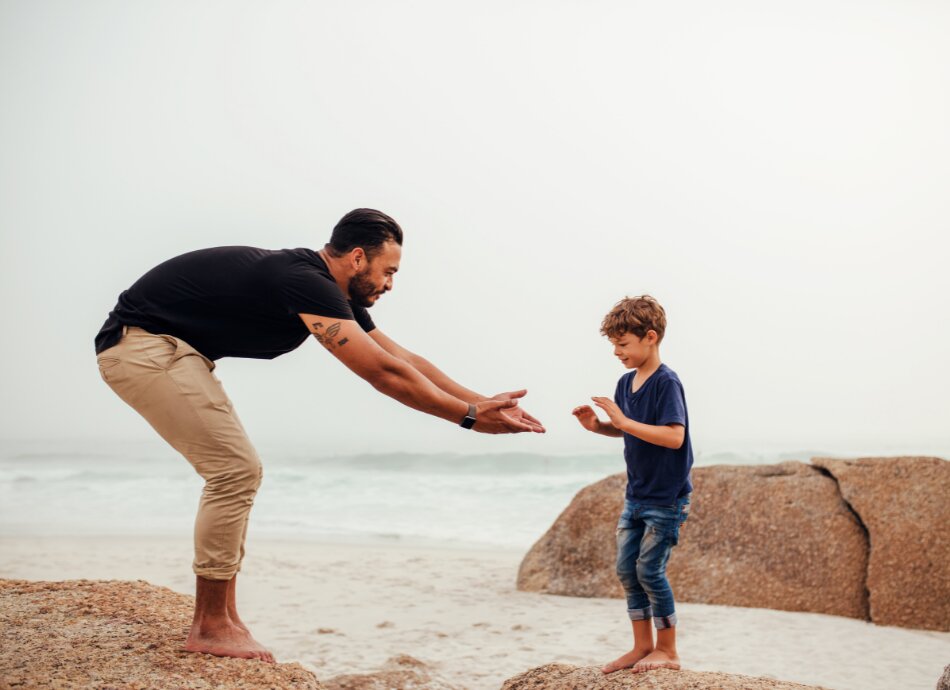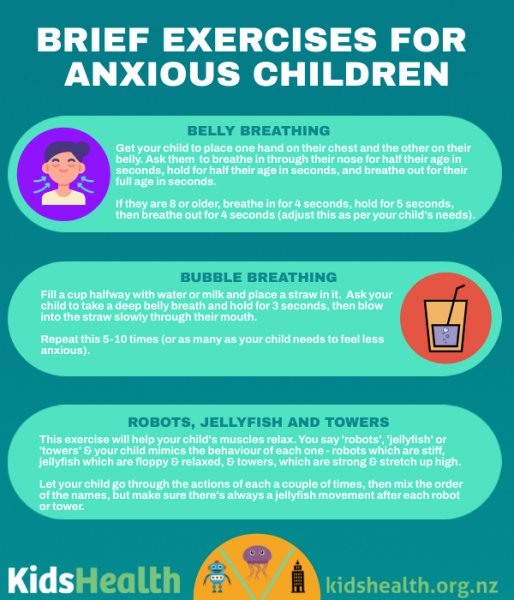Low or no data? Visit zero.govt.nz, scroll down the page then click on our logo to return to our site and browse for free.
Anxiety in children
Key points about anxiety in children
- Anxiety is a common and natural feeling that everybody experiences.
- If anxiety is significantly impacting on your child's everyday life, then it is important to get help for them.
- Anxiety disorders can be treated effectively.

Anxiety is a common and natural experience. Many people feel it, regardless of their age. Anxiety is a normal response when faced with something that is threatening or dangerous, embarrassing or stressful because it prepares us to manage the situation.
However, some children may feel anxiety more intensely and find it harder to get their anxious feelings under control. Someone experiencing anxiety might feel ‘on edge’, overwhelmed, worried or frightened. They might dread something bad is going to happen or feel panicked. Some people experience a range of physical symptoms, eg, stomach aches and headaches.
For tamariki and rangatahi, there are common fears that are often associated with age. For example, infants may fear separating from their parents. Young children often fear insects and animals. Some children may also be scared of the dark or will imagine there are monsters under the bed.
Teenagers also have many anxieties including worrying about fitting in and being judged by other people. Performance anxiety is common amongst children and young people competing for high levels of sporting or academic excellence.
Some tamariki may feel anxious as they come across new experiences and situations. They think the fear or danger they’re worried about is much greater than it actually is. Thinking about the situation can make them more worried and tense.
Anxiety is one of the most common challenges experienced by tamariki and rangatahi. Both boys and girls are affected. Sometimes the anxiety can be greater than that of their peers and interfere with the young person's life – how they manage on a day-to-day basis. This may be a sign that an 'anxiety disorder' is developing and treatment for this may be necessary.
No one knows what causes anxiety, but research has shown the following 4 factors contribute to anxiety:
- Temperament.
- Genetics.
- Learned behaviour.
- Negative experiences.
People who have an anxiety disorder are likely to worry more than other people and be more sensitive to danger. Research has also shown that anxiety can run in families. When parents are anxious, their children may learn they should also worry a lot. Negative events that have happened in a person's life can also cause anxiety. For example, if a dog bites a child, the child may become scared of dogs.
Anxiety is usually experienced in 3 different ways – physical feelings, thoughts and behaviour patterns.
Physical sensations
Your child may experience physical symptoms of anxiety. This is often called the fight-or-flight response and refers to the body doing a number of things to prepare for quick action or a quick escape from the potential danger.
Your child might experience:
- increased heart rate
- heavy or rapid breathing
- stomach aches
- nausea (feeling sick)
- vomiting (being sick)
- diarrhoea (runny poos)
- headaches.
Thoughts
Tamariki who experience anxiety sometimes think something bad is going to happen. They may worry about a threat or danger that may seem bigger to them than it actually is.
Children and young people may:
- think the worst will happen
- ask for help with things they can do for themselves
- worry a lot about doing things right
- ask “will you do it for me?” or “will you tell them for me?” a lot
- have a lot of ‘what if’ thoughts, such as ‘what if I can’t do this?’
Behaviour patterns
Avoidance is the main behaviour pattern of anxiety. This can be obvious like refusing to do something they are fearful of, eg, going outside when it's dark. Or it may not be so obvious, like staying with someone they know so they don’t have to talk to strangers.
Other behaviour patterns include:
- clinging to a parent or caregiver
- fidgeting, pacing, or shaking
- not going to sleep without a parent or other adult
- preferring to watch others rather than have a go
- fearing things such as the dark, dogs, injections, being alone, germs, tests
- crying over small things
- complaining about being picked on a lot.
Read more about the different anxiety disorders(external link).
Watch this video developed by Anxiety Canada to learn how anxiety keeps us alive, and how worries in your head affect what you feel in your body.
There are some things you can do to help your child manage their anxiety.
Acknowledge
Acknowledge your child’s feelings. Let them know that it is normal and common to feel anxious and that lots of other people are also having similar feelings.
Remind
Remind them of times they have been brave in the past. Tell them they are loved, cared for and safe (in whatever realistic or truthful way they are).
Praise
When your child makes steps towards something that you know makes them anxious then praise them.
Problem solve
Encourage your child to think of ways to solve his or her problem, rather than saying “Don’t worry!” or “Everything will be fine!”. For example, you could say: “If (the worst) happens, what could you do?” or “Let’s think of some ways you could handle that situation”.
Be calm
Tamariki and rangatahi look to the important adults around them to determine how worried they should be.
Talk openly
Talking to your child about the things that make them anxious can help reduce the anxiety they feel. It will also help you understand what’s going on for your child, and place you in a better position to help them manage their anxiety and find solutions.
Here are some strategies to support anxious children(external link).
Brief exercises to help anxious children
Try these simple and short exercises for anxious children from Anxiety NZ.
Image credit: KidsHealth NZ
If anxiety is having a significant impact on your child's everyday functioning and preventing them from doing activities that their peers can comfortably do, this is a sign that you should seek help.
Tamariki may need some extra support when:
- they feel anxious more than other children of a similar age
- anxiety stops them participating in activities at school or socially
- anxiety interferes with their ability to do things that other children their age can do
- their fears and worries seem out of proportion to the issues in their life.
It's important to have an assessment by a professional who knows about anxiety in children and young people. It's also a good idea to have a physical check to make sure there is no underlying illness causing the symptoms.
Research has shown a form of psychological therapy (cognitive behavioural therapy) is effective in learning ways to overcome or manage anxiety. Your healthcare provider may recommend medicine if the anxiety is very severe or if there are multiple difficulties at the same time (such as depression). If your healthcare provider does prescribe medicine, then psychological therapy should also be part of the treatment.
Going to your family healthcare provider is the best first step as they will be able to provide guidance about where to get more help. This may involve a referral to a counsellor in the community or to a local child and adolescent mental health service who can provide specialist assessment and interventions for anxiety.
Credits: Content shared between HealthInfo Canterbury, KidsHealth and Healthify He Puna Waiora as part of a National Health Content Hub Collaborative.
Last reviewed:






